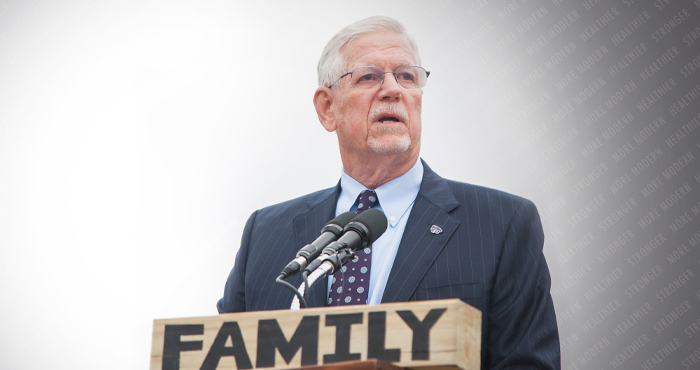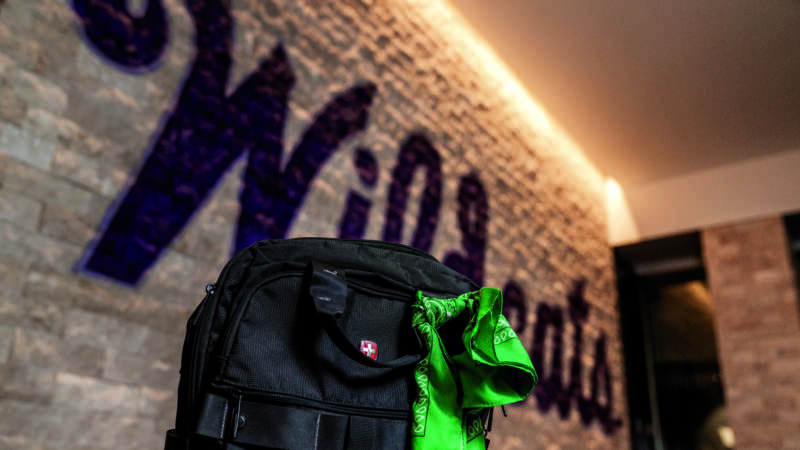On the occasion of his retirement, we look back at how President Richard Myers’ leadership changed K-State for the better
During the five years of Richard Myers’ presidency, K-State has faced a pandemic, dealt with declining enrollment and funding, examined how racial and social justice issues impact the whole university, expanded resources for mental health and food security, and strategized how to be more relevant in addressing global issues.
In the following pages, we reflect on President Myers’ time at K-State — the challenges and the successes — and how the extraordinary leadership of our 14th president prepared us for the future.
It didn’t take long for Richard Myers, president of Kansas State University for the past five years, to decide what had been one of his and the university’s most important accomplishments. “It would have to be one nobody anticipated, which is dealing with the pandemic and coming out of that probably stronger than when we went into it,” he said. “The challenges it presented made us realize we’re probably going to have to pivot to the future as a university. Using the pandemic as some leverage to move the university forward when we might not have had the incentive to do otherwise, will be very helpful in the future.”
Dealing with the pandemic has made K-State leaders think about more than how they deliver education; they are also evaluating what degrees they are offering. “We’ve started taking a universitywide view of our program offerings to see if we’re offering what students need, what society needs and what we’re good at,” Myers said. “We have to get ready for the future by offering more classes and programs that are interdisciplinary and multidisciplinary. This approach is in demand and needed by society to deal with some of the complex problems our world has that can’t be solved by one discipline. The way we ensure K-State’s future is to have the kinds of offerings people want and to produce the kind of talent the world needs.”
When Myers was named the 14th president of K-State in 2016, university leaders hoped his ability to “tell it like it is” would make the state legislature listen to his and the Board of Regents’ concerns about declining state investment in higher education. Twenty years ago, state appropriations to K-State funded 34.5% of the university’s budget. This past year it was down to 18.8% of the budget. Declining state support means students and their families shoulder more of the financial costs of earning a degree.
“The biggest challenge, in my view, is helping people in Kansas, particularly in the state government, to realize the value of higher education,” Myers said. “If we want to be a prosperous state, they need to support higher education. All universities, but especially the big research universities, contribute to economic prosperity. Yet we continue to see a decrease in support from the state government. Kansas’ college-attending rate is toward the bottom of the U.S., and that’s not a good place to be if you want to have a prosperous state where industry want to be; a state where people want to come and live.”
Thankfully, philanthropy has helped to fill some of the financial gaps. The Innovation and Inspiration Campaign raised $1.6 billion for K-State, providing scholarships for students, faculty awards to attract and retain outstanding faculty, support for academic programs and facility upgrades.
“Beyond philanthropy, I think the real estate development capacity the KSU Foundation now has is a game changer,” Myers said. “With the Edge Collaboration District, the foundation is helping K-State develop opportunities with business partnerships, internships for our students, and bringing jobs and a stronger economy to the community.”
Despite reduced state funding, K-State continues to rank high in many categories:
No. 1 Best value college in Kansas (SmartAsset, 2021)
No. 1 Highest starting salaries in Kansas (SmartAsset, 2018)
No. 1 Happiest students (Princeton Review, 2021)
No. 2 Best loved colleges (Princeton Review, 2021)
No. 3 Best health services (Princeton Review, 2021)
No. 3 Best quality of life (Princeton Review, 2021)
No. 4 Best town-gown relations (Princeton Review, 2021)
No. 7 Best counseling services (Princeton Review, 2021)
No. 9 Best athletic facilities (Princeton Review, 2021)
Stronger
Building on this position of strength, K-State, under Pres. Myers’ leadership, began addressing underlying issues that were preventing the K-State community from becoming as strong as possible, mainly making sure everyone at K-State felt valued, respected, included and had equal access to opportunities. “We’ve made some pretty good strides in becoming a more diverse and more inclusive university,” Myers said. “It’s a journey. It’s never over, but there has been some real progress.”
K-State has adopted Principles of Community that all are encouraged to acknowledge and follow.
We affirm the inherent dignity and value of every person and strive to maintain an atmosphere of justice based on respect for each other.
We affirm the value of human diversity and inclusion for community. We stand united against all forms of discrimination.
We affirm the right of each person to freely express thoughts and opinions in a spirit of civility and decency. We believe that diversity of views enriches our learning environment, and we promote open expression within a climate of courtesy, sensitivity, and mutual respect.
We affirm the value of honesty and integrity and will act accordingly in all professional endeavors and expect the same from our colleagues.
We acknowledge that we are a part of multiple communities, and we have a responsibility to be engaged in a positive way with our civic partners.
We recognize our individual responsibilities to the university community and to the principles that sustain it. We will each strive to contribute to a positive spirit that affirms learning and growth for all members of the community.
“After the George Floyd murder and the nationwide concern about social justice, we have created an 11-step action plan with distinct steps to address racial and social justice issues at K-State,” Myers said. “We created this plan with a lot of student help. We looked at all our policies, procedures and processes to make sure there wasn’t discrimination or bias built in, and we’ve revamped all of those. We are working to make K-State more diverse and more inclusive with this comprehensive action plan, which some of it is still being developed and completed.” (To learn more about the action plan and the Principles of Community, visit k-state.edu/diversity-inclusion.)
Myers’ biggest challenge, the COVID-19 pandemic, also made K-State stronger. “People may not realize it now, but I think we’re more resilient. We were slapped in the face and we got up and did what we were supposed to do as a land-grant university,” Myers said. “Take the faculty, for example. They were given one week to get their classes up online. Some could do that pretty well, but others needed help. We got people through that semester and got people graduated. I think that’s one example of how we’ve built resiliency.”
Healthier
The pandemic forced many people and institutions to think about what is vital to survive and thrive, and that’s true at K-State. “One of the things we’ve learned is how important our Lafene Health Center is; what a central role they played in the pandemic, and what a critical resource they are for campus,” Myers said.
During Myers’ tenure, several aspects of health for all Wildcats have been improved, and philanthropy has played an important part. Cats’ Cupboard supports students, faculty and staff with food and personal essentials. Powercat Financial teaches students how to budget and manage their expenses and to plan for their financial future. Counseling and Psychological Services help guide students through life’s challenges. All of these programs are supported by philanthropy and overseeing all of these services is the new Morrison Family Associate Vice President for Student Well-being Kathleen Hatch.
“Her efforts will help foster a culture of well-being at K-State that connects students to the right resources at the right time and in ways that work for them,” said Thomas Lane, vice president for student life. “The last five years, and especially the current pandemic, has highlighted the powerful connection between a student’s sense of well-being and their personal and academic success. Along with academic support, providing resources and opportunities for students to thrive in key aspects of their lives — emotionally, physically, socially and financially — helps ensure they achieve their goals at K-State and beyond. The caring and generous support from the K-State family has been pivotal in helping us address student well-being and will be critical for us moving forward in expanding much-needed programs and services.”
Energy is high on campus to bring change as society is growing and adapting to how overall well-being is addressed, and Hatch is excited to build on that feeling. “COVID-19 has disrupted all patterns and so this is a good moment, as patterns are being reestablished, to focus on well-being as an essential element to advance learning, persistence and student success,” Hatch said. “The fragility of the human experience has been made visible, and these are new strategies, at an institutional level, to create a chance to strengthen and elevate the beautiful K-State character and extended family.”
More modern
The most obvious, visual proof that K-State is becoming more modern are the new and renovated facilities on the Manhattan and Salina campuses, nearly all funded through private gifts. “Think back to the new construction since I came here as president; it was mostly all done with philanthropy,” Myers said. “Whether it was the expansion of McCain Auditorium or the Morris Family Multicultural Student Center, those were done with philanthropic dollars. Jim Bob Morris, a former K-State football player of Cherokee descent, made the lead gift for the center. He hopes it’s a bridge for better understanding with all people.”
“I’d also say, we didn’t have a chief diversity and inclusion officer on the president’s cabinet when I came here,” Myers said. “We put that in place and that will live on, which is very important. We weren’t very modern when it came to that piece of our administrative oversight.”
Administratively, remodeling the budget and revamping the strategic enrollment management (SEM) system are two more ways K-State has modernized under Myers’ leadership. “We had a budget model that was antiquated and out of date, so we revamped that and are implementing that now,” Myers said. “The new model rewards performance and holds people accountable. The methodology and process are much more modern now.”
When Karen Goos, vice provost for enrollment management, started at K-State in 2019, she encountered a big challenge. “The biggest challenge I encountered were our processes. We had dated technology, lack of knowledge about market-based best practices and manual processes that prevented us from doing any personalized outreach in a scaled way,” Goos said.
A $5 million gift from Greg and Mamie Case enabled Goos’ office, with collaboration from the provost and student life offices, to invest in the necessary technology and research to greatly improve K-State’s strategic enrollment management system.
“The philanthropic support allows the university to be nimble in our approach to developing. It also allows the university to quickly catch up to be more competitive in the market compared to others who have been working on strategic enrollment management efforts for many years,” Goos said. “Great examples include our ability to text prospective students, offer a virtual tour, increase our early high school programs and increase access to the university by offering increased application waivers, all made available because of the philanthropic support we received. These kinds of changes are major game-changers that would have taken the university many years to stand up. Instead, we have been able to implement all of them within the last 18 months.”
The investment is already bringing positive outcomes. “We have seen enrollment gains in almost every student population,” Goos said. “Last year we saw increases in our transfer, international, graduate and online students. We are really optimistic about the future of K-State enrollment. We are better positioned today than ever before to share the story of K-State and what makes the university so special.”
Going forward
The new president of Kansas State University will have their own priorities. But one area Myers suggests the KSU Foundation and K-State donors focus on is updating and upgrading classrooms. “We have a lot of infrastructure that is very old. Some of that needs to be modernized, and some of it needs to be replaced,” Myers said. “I don’t think we can count on the state to help us too much in that endeavor, so we’ll have to turn to philanthropy.”
A new initiative at the KSU Foundation has been started to renovate classrooms on campus. Similar to the successful K-State Family Scholarship match program, the foundation is seeking donors to invest matching funds to inspire more gifts, spurring the number of classrooms K-State can upgrade more quickly. University leadership has identified more than 276 classrooms to be renovated
Improved facilities help recruit and retain students, faculty and staff to K-State, and make the learning experience more effective and enjoyable. New and renovated facilities, on campus and in the Edge Collaboration District, also enhance K-State’s reputation as THE place to be for agriculture, global food systems, and animal and human health, One Health. “New infrastructure so close to the National Bio- and Agro-defense Facility will help us attract a lot of industry and give us bragging rights about being the Silicon Valley of bio and agro-defense,” Myers said.
A grateful exit
Kansas State University has played a major role in President Myers’ life. He came to K-State as a student and met Mary Jo Rupp at a fraternity football game. Mary Jo graduated in 1964 with a degree in English and Myers graduated in 1965 with an engineering degree. They got married in All Faith’s Chapel the summer of 1965.
Myers’ military career kept them moving, a total of 26 times, but everywhere they went, they both made a difference. Mary Jo has a rich background in public service related to military, educational and humanitarian organizations. A military spouse for more than 40 years, she has won multiple awards for her humanitarian work. And Myers rose through the ranks to become Chairman of the Joint Chiefs of Staff before retiring as a four-star general in the U. S. Air Force.
The Myerses have been KSU Foundation Trustees since 2005, and Myers served on the Board from 2008 to 2015. They co-chaired the Innovation and Inspiration Campaign with Rand and Patty Berney. They give of their time and money to K-State, supporting a variety of programs across campus and lending their expertise in the classroom.
As the Myerses make their plans for retirement, one thing is certain — K-State will continue to hold a special place in their hearts.
“This is a great place for students, and I’m humbled and grateful that I had a chance to come back,” Myers told KSU Foundation Trustees at their fall meeting September 17, 2021. “I’ve had about every role you can have here, from student ROTC cadet to a graduate to an alum to a donor to president. I mean, it’s when you think about that kind of scope, it’s certainly quite meaningful to me, so I thank you all.”
Highlights of Pres. Myers’ five years as K-State president
- Advocated for increased state investment in higher education
- Steering K-State through a pandemic
- Intentional work toward diversity, equity and inclusion
- Modernized budget model
- Improved strategic enrollment management system
- Well-rounded focus on student well-being
- Curriculum review toward a more multidisciplinary approach



